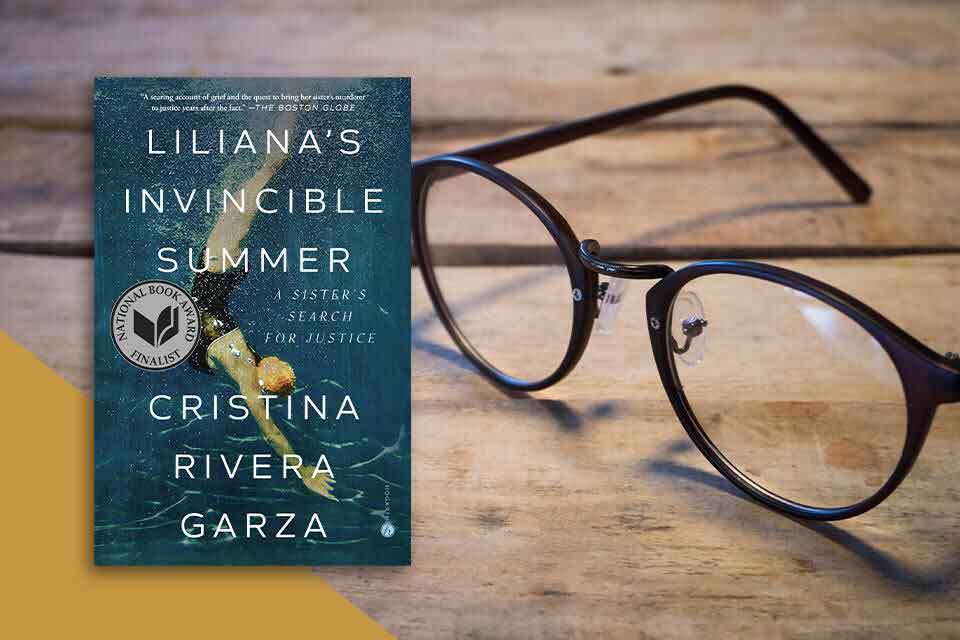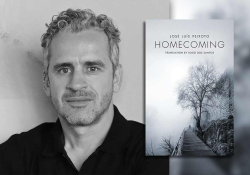Writing for Her Life: Cristina Rivera Garza’s Liliana’s Invincible Summer
 In the book dedicated to her sister Liliana, who was murdered at the age of twenty by her ex-boyfriend on July 16, 1990, Cristina Rivera Garza includes transcriptions of telephone interviews she conducted with friends who knew Liliana roughly three decades earlier, when she was studying architecture at the Iztapalapa campus of Mexico City’s Autonomous Metropolitan University. One of those friends is Norma Xavier Quintana, who recalls that Liliana encouraged her to stay true to herself after a romantic betrayal by passing her a note that read, “In the midst of winter I found there was, within me, an invincible summer.” In addition to being the inspiration for the book’s title, this sentence is also its epigraph, whose author Rivera Garza identifies as Albert Camus.
In the book dedicated to her sister Liliana, who was murdered at the age of twenty by her ex-boyfriend on July 16, 1990, Cristina Rivera Garza includes transcriptions of telephone interviews she conducted with friends who knew Liliana roughly three decades earlier, when she was studying architecture at the Iztapalapa campus of Mexico City’s Autonomous Metropolitan University. One of those friends is Norma Xavier Quintana, who recalls that Liliana encouraged her to stay true to herself after a romantic betrayal by passing her a note that read, “In the midst of winter I found there was, within me, an invincible summer.” In addition to being the inspiration for the book’s title, this sentence is also its epigraph, whose author Rivera Garza identifies as Albert Camus.
In her return to her sister’s vital presence, Rivera Garza encounters someone who recalls Liliana’s use of Camus’s words. “Return to Tipasa” (1953) is the text by Camus that includes the sentence, which arises upon a return, after many years in Europe, to the Roman ruins in the Algerian town of the essay’s title. There Camus finds that, “In Tipasa, the world is born again each day in a light always new.” Rivera Garza describes how Liliana returns to her within the pages of Liliana’s Invincible Summer: A Sister’s Search for Justice (Penguin Random House, 2023), a book that, in turn, embodies Rivera Garza’s return to Liliana. Even though the book centers upon Liliana’s femicide, and by extension the fate of countless women, one of its primary accomplishments is to provide a space in which, paradoxically, Liliana’s death and life both bear on the present as forces of change and renewal.
Language plays an essential role in Rivera Garza’s consideration of how to remember her sister’s life and condemn the pervasive and persistent circumstances of hers and others murdered because they are women. For example, death and continuity appear side by side in the insistence with which she writes, in the context of a visit to Liliana’s grave on October 4, 2020, “It would have been her fifty-first birthday. It is her fifty-first birthday.” This contradictory claim appears in the same section of the book that specifically addresses the urgent need for renewed language: “Who, in that summer of 1990, could have said, with their head held high, with the strength conferred by the conviction of being right and truthful, It was not her fault, nor did it matter where she was or how she dressed? Who, in a world where the word femicide did not exist, the term intimate terrorism did not exist, could have said what I now say without the slightest doubt: the only difference between my sister and me is that I never came across a murderer?” Here Rivera Garza remarks on language’s power. Throughout, her book enacts it. Her writing expresses the magnitude of Liliana’s absence much less by describing her death or the grief of those who loved her than by sustaining her sister’s vitality. The pair of sentences that keep Liliana dead and alive and the recognition of the power to name the dangers women face are two of the author’s own contributions to a book whose force of renewal comes primarily from its collaborative structure, that is, from efforts that place its main author in the role of archivist and scribe of a living legacy.
Rivera Garza’s writing expresses the magnitude of Liliana’s absence much less by describing her death or the grief of those who loved her than by sustaining her sister’s vitality.
At once a description and a part of this legacy, Liliana’s Invincible Summer is a transformation of its original Spanish-language incarnation, El invencible verano de Liliana, published two years earlier, in 2021. Rivera Garza translated the Spanish version herself, and although the books are mostly the same, she did make some changes, including the addition of several photographs, brief explanations of Mexican references likely unknown to most English-language readers, and the reordering or omission of some of Liliana’s friends’ transcribed conversations. Rivera Garza’s translation of a book she had already written makes for yet another intimately involved return to her sister’s life and death. Three substantial differences between the Spanish and English versions highlight the nuance and care with which Rivera Garza remembers Liliana. First, both texts refer to an abortion Liliana had, but only the English version mentions the letter Liliana wrote to a high school friend about the procedure’s emotional and physical effects. Second, a comparison of the different books’ descriptions of a trip Rivera Garza took to Mexico in 1990, which was the last time the sisters would see one another, highlights a remarkable addition to the English version: “In the only image that remains from that visit to Mexico City, my first ever author picture, I am wearing my sister’s glasses.” At the beginning of her published writing career, Rivera Garza’s readers see her seeing through her sister’s lenses. Third, in both versions Rivera Garza describes the ominous song Liliana wrote about in her diary on the night of July 14, 1990, less than two days before her ex-boyfriend killed her: “While the lyrics have the singer begging for the lover not to abandon her, adamant about not letting go, Liliana chose to highlight three lines in which the forlorn lover hints at the existence of a life threat.” In the Spanish version, Rivera Garza writes that despite her best efforts she has been unable to identify the song. In the English version, she names the song, its writer, and the artist who performs it. The English version demonstrates Rivera Garza’s drive to continue researching the details of her sister’s life and death, to become in a sense her own collaborator.
Collaboration and doubling back on one’s words and experiences are motifs that appear throughout and structure both versions of the book, as evident clearly in the triple appearance of Camus’s phrase and its provenance in an essay about a writer’s returns to the Roman ruins he often visited as a child. Liliana’s ruins take the form of an archive within the archive that Rivera Garza continues to care for. For example, Rivera Garza cites several letters Liliana wrote to her, other family members, friends, lovers, admirers, and the man Liliana dated off and on for years and who would kill her. Liliana sometimes copied her letters or made drafts of those whose final versions she eventually sent. Some she kept without sending at all. After opening boxes left closed for thirty years, Rivera Garza returns to the letters, Liliana’s diaries, notebooks, and other items, including “brushes and stickers, pens, X-Acto knives, vellum paper and Fabriano paper.” Not only do Liliana’s words remain, so does the way she wrote them. Rivera Garza describes in bittersweet detail the types and colors of pens, pencils, and paper Liliana often used. She observes how the still-visible pressure of the pen on the page conveys Liliana’s emotions. To replicate this materiality in the book, Rivera Garza includes facsimiles of Liliana’s notebook pages and an especially dense typewritten letter to her close friend Ana Ocadiz. Furthermore, one of Liliana’s classmates, Raúl Espino Madrigal, crafted the typeface used for transcriptions of her writing.
Liliana’s ruins take the form of an archive within the archive that Rivera Garza continues to care for.
Rivera Garza places her book in dialogue with the writing of many others, including those who appear in Liliana’s handwriting in copies of poems by Geoffrey Chaucer and José Emilio Pacheco. Her return to her sister’s life speaks eloquently and vehemently while lamenting the silence or euphemisms that made warning signs of deadly danger harder to see in 1990. She contextualizes this continuing dilemma in references to Rachel Louise Snyder’s 2019 book No Visible Bruises: What We Don’t Know about Domestic Violence Can Kill Us. In addition to the poems Liliana transcribed, complete texts reprinted in the book include the reports on Liliana’s murder that journalist Tomás Rojas Madrid wrote for La Prensa, a Mexico City daily. Though only cited briefly or referred to, Rosario Castellanos and Michal Ondaatje also help guide Rivera Garza’s return to Liliana.
A support system of texts within and beyond the pages of Rivera Garza’s book defines it clearly as the result of multiple and often collective efforts that span centuries of literature, decades of the author’s grief and rage—Liliana’s murderer was never brought to justice—and the years of love, solidarity, friendship, and occasional frustrations that defined Rivera Garza’s life together with her younger sister. The sisters’ parents collaborate as well, recounting Liliana’s childhood, her intelligence, force, and independence, as well as their terrible sadness. The book’s place within and among so many different stories gives to Rivera Garza’s readers the value of Liliana’s singular life. The book’s interconnectedness also suggests multiple stories of loss that will remain mostly or completely untold while affirming the value of the lives that persist at the heart of each one.
University of Maryland
Editorial note: Dr. Long’s reviews of Rivera Garza’s New and Selected Stories and La Castañeda Insane Asylum have also appeared in WLT.















